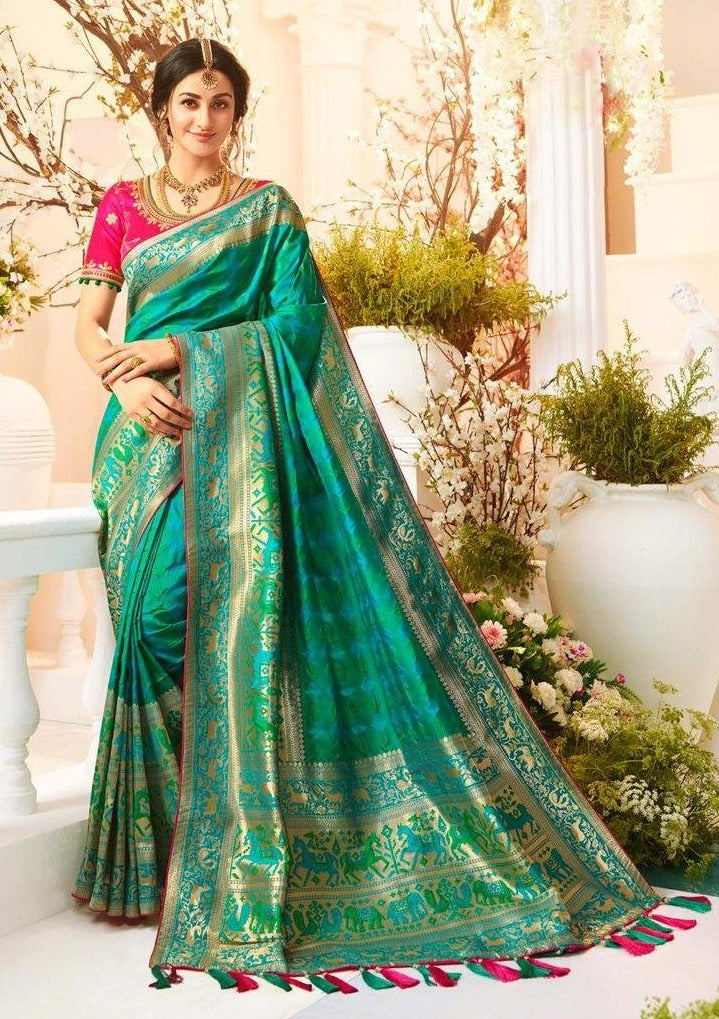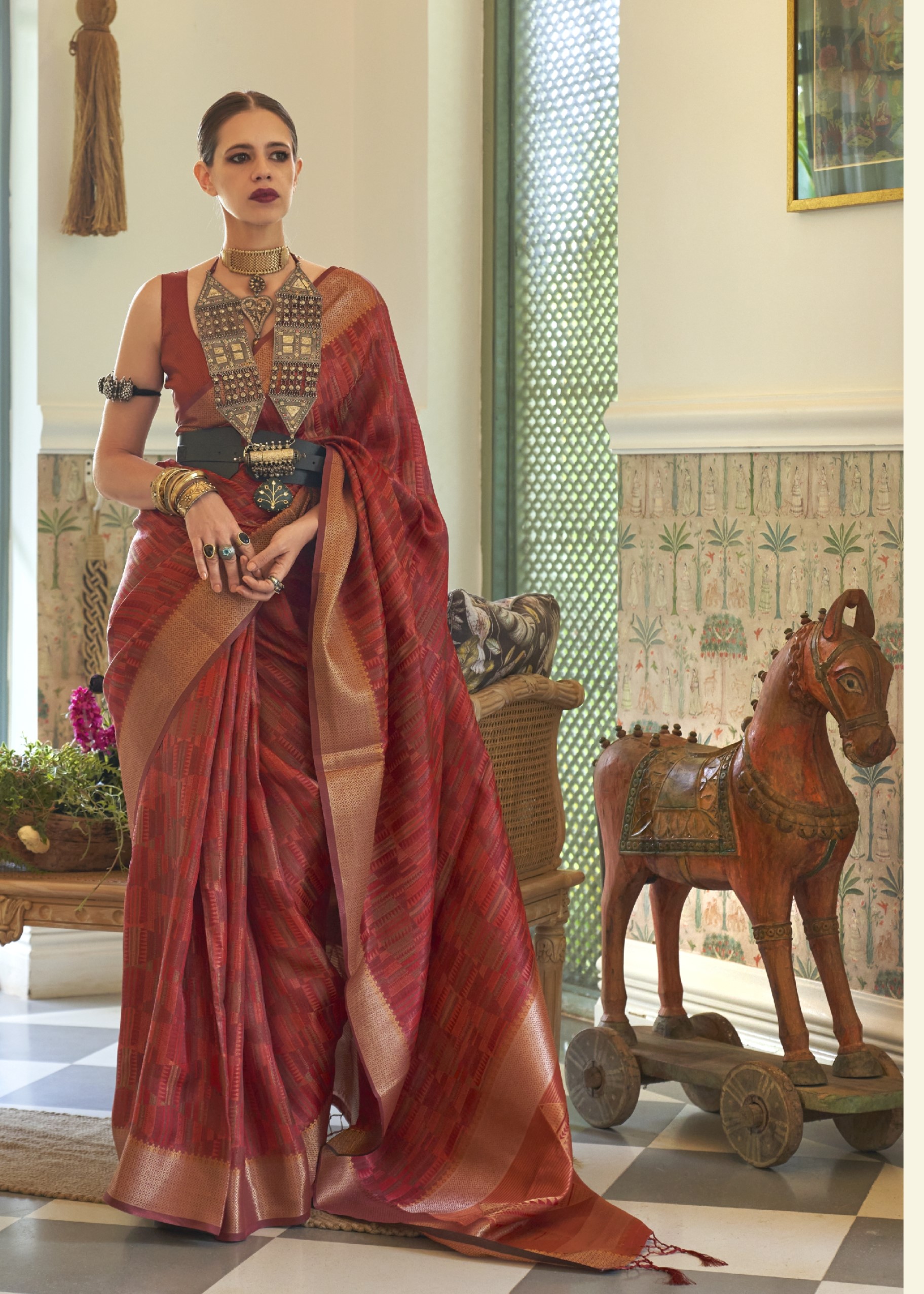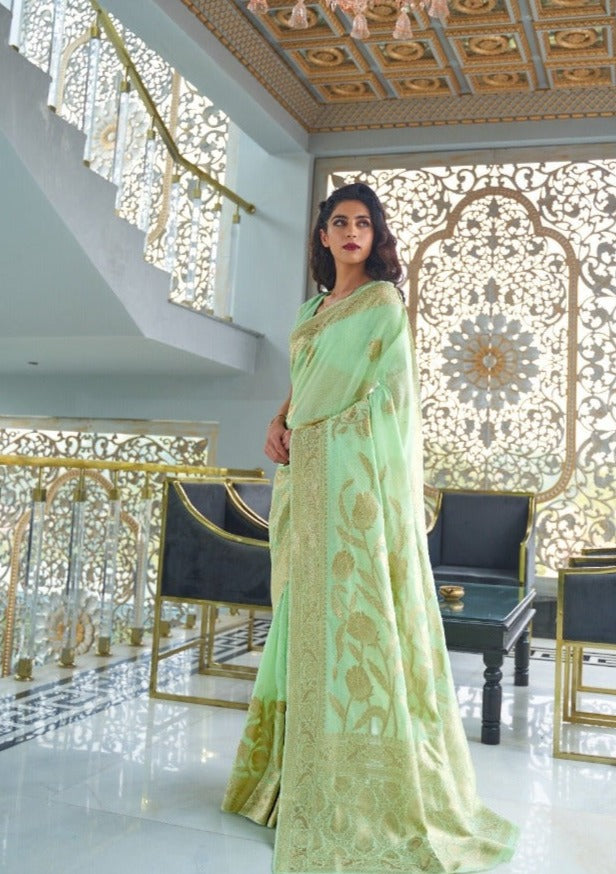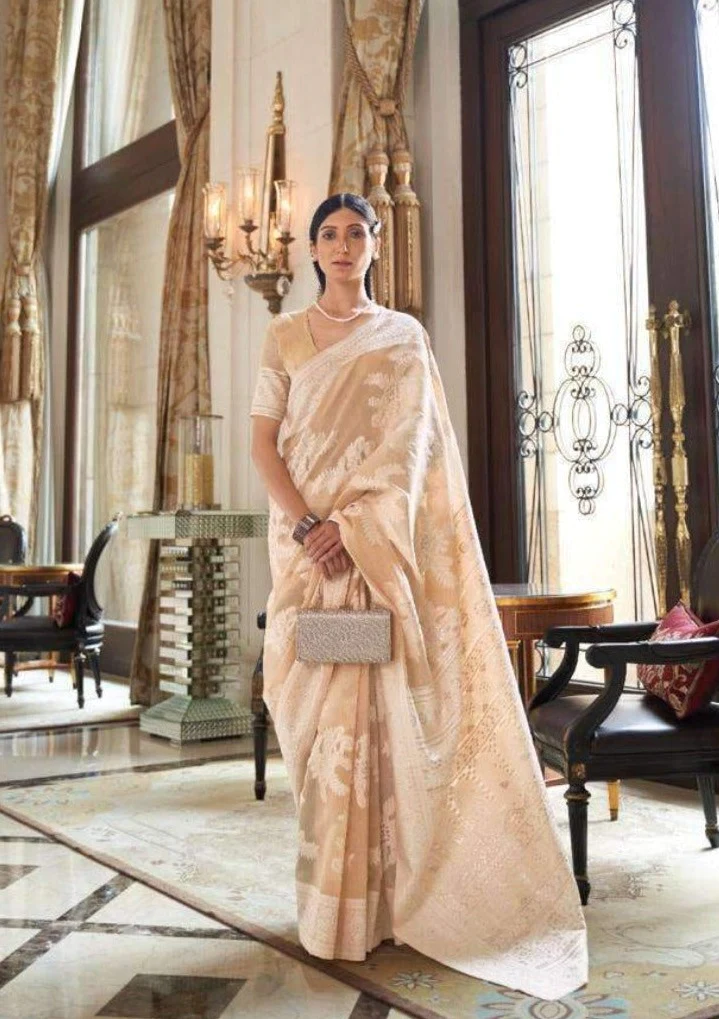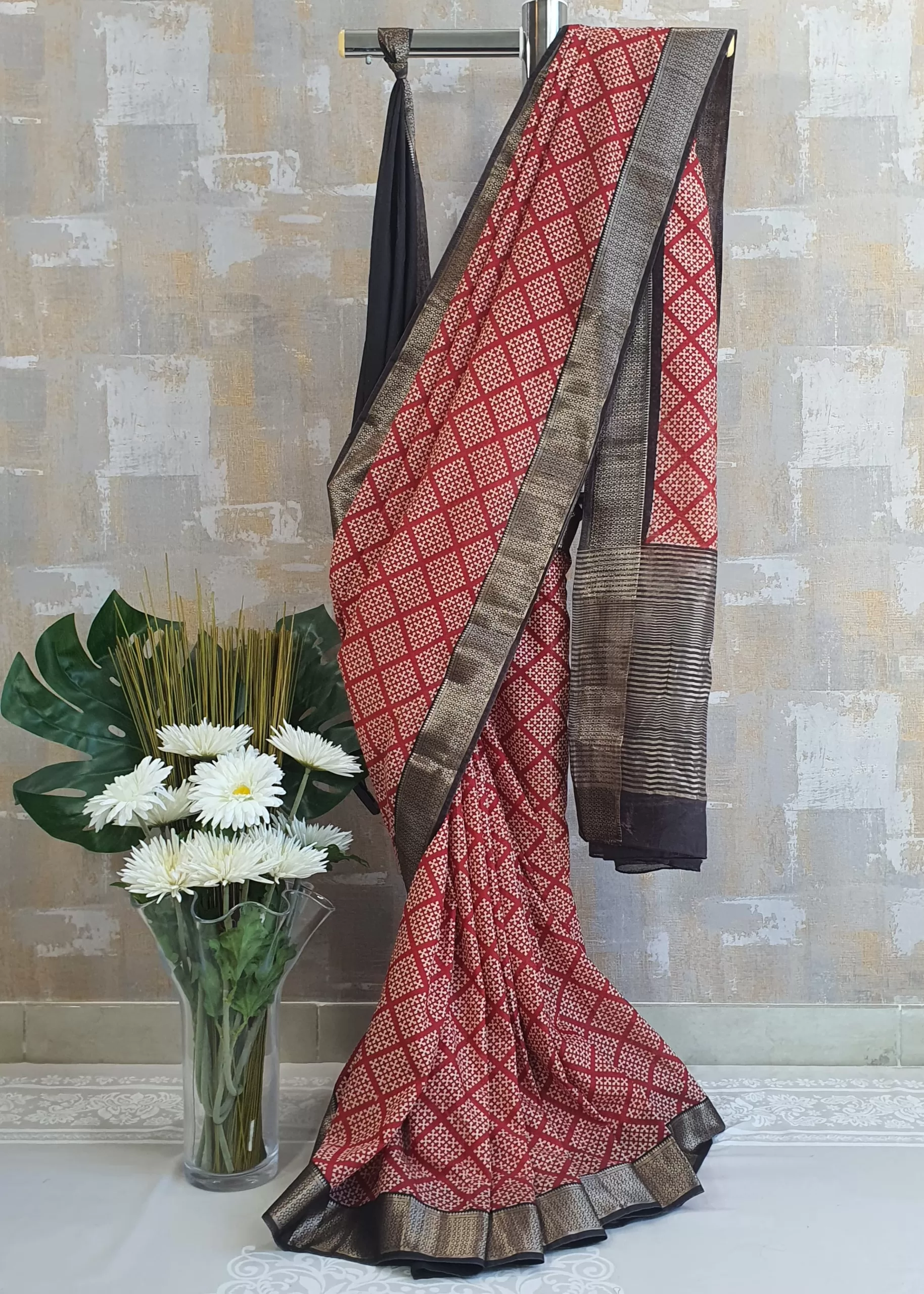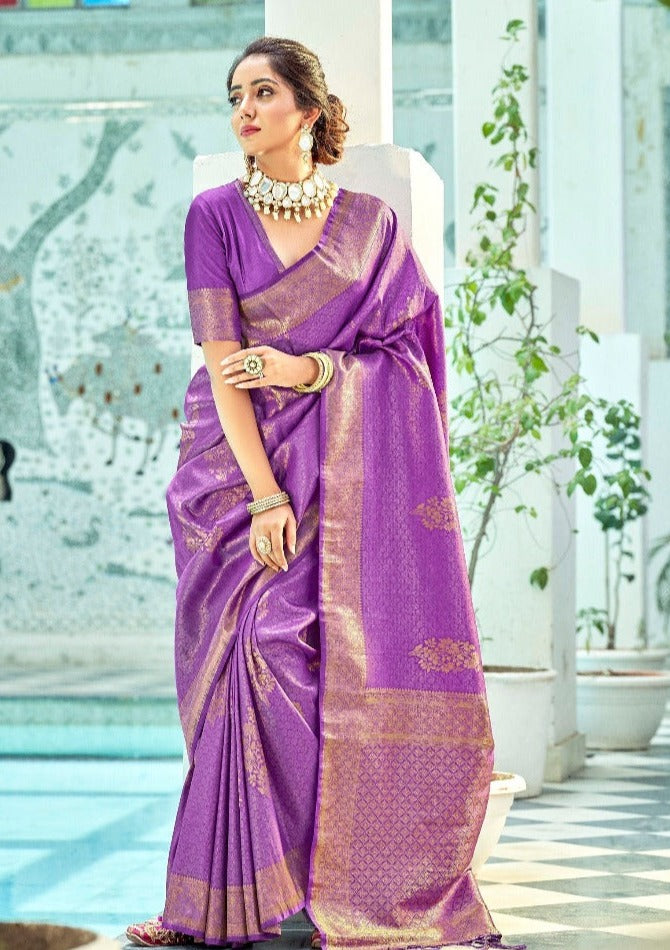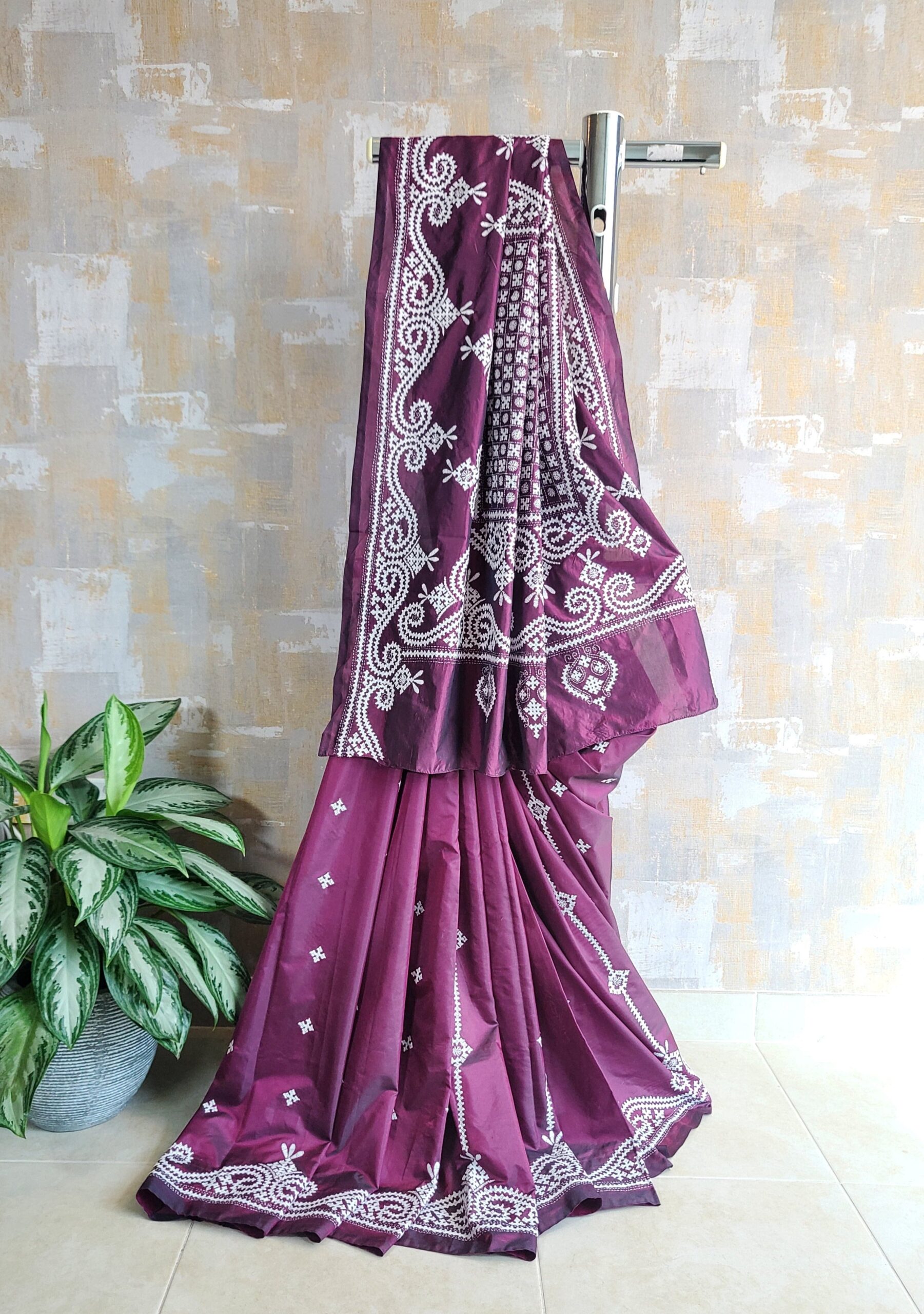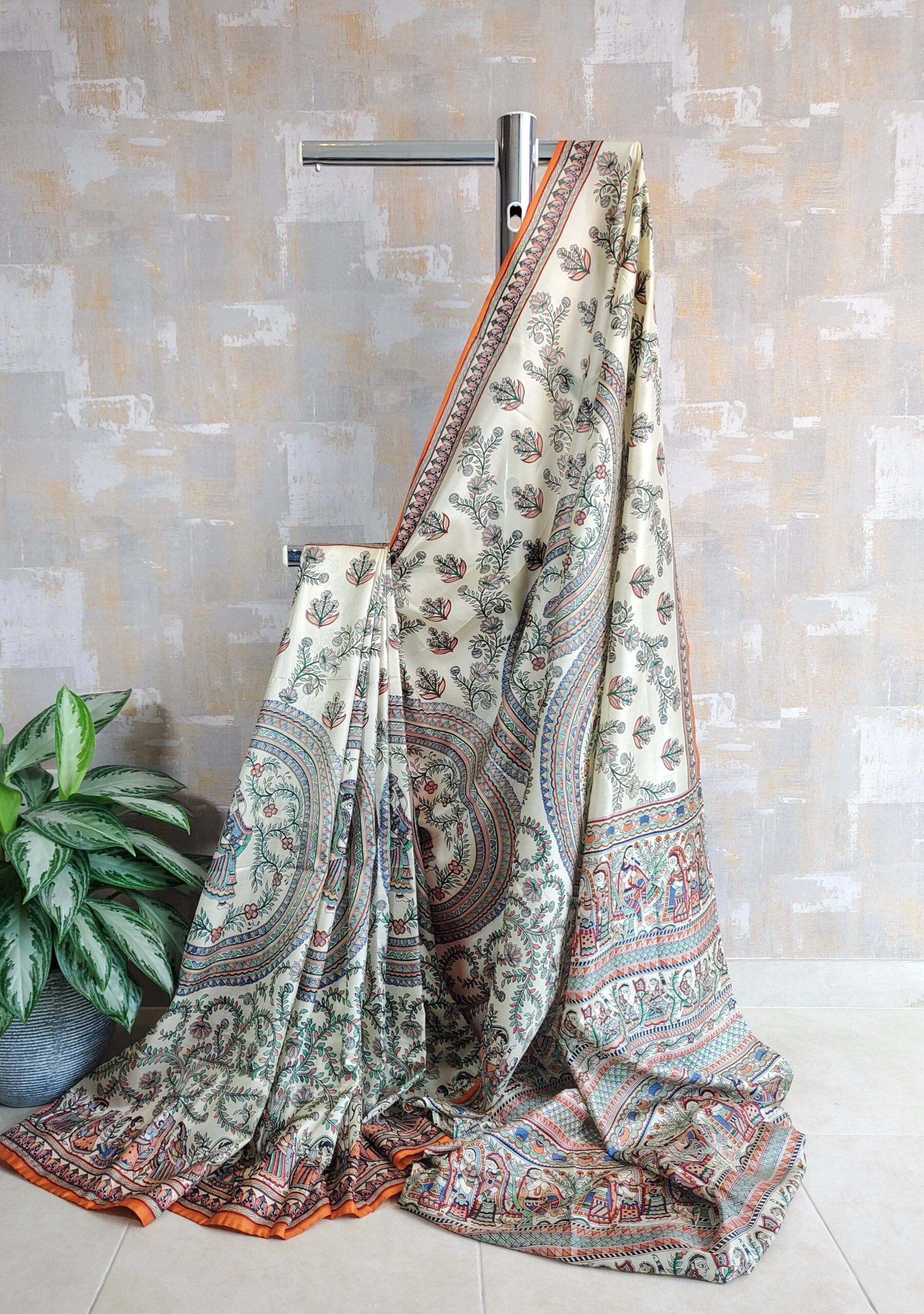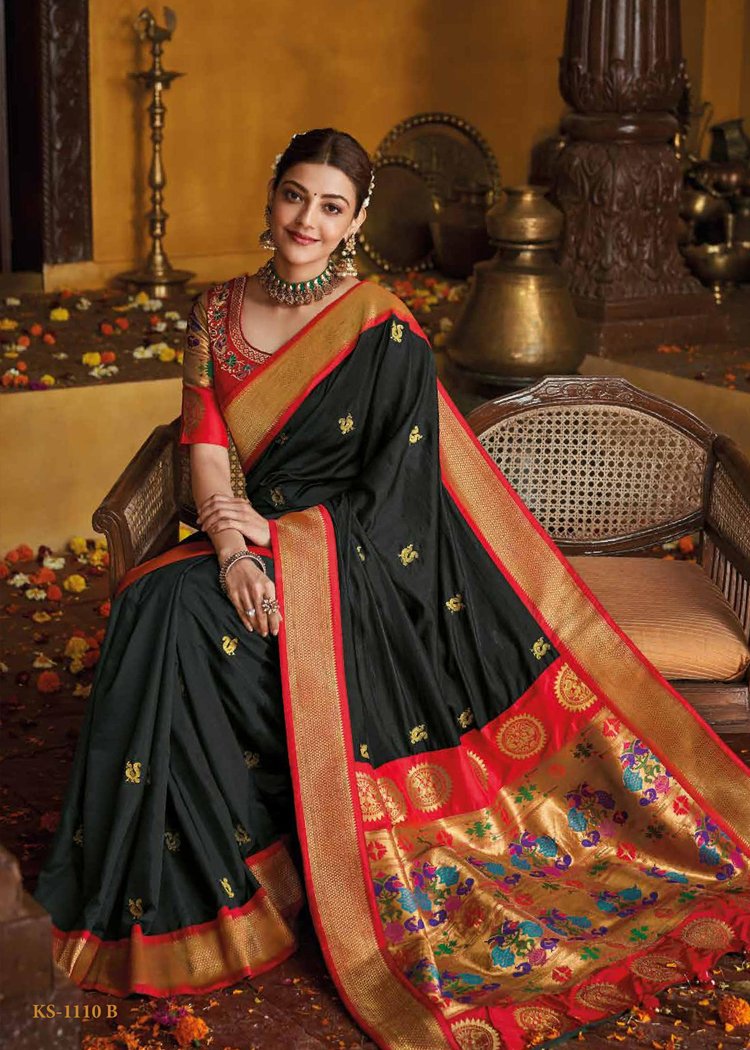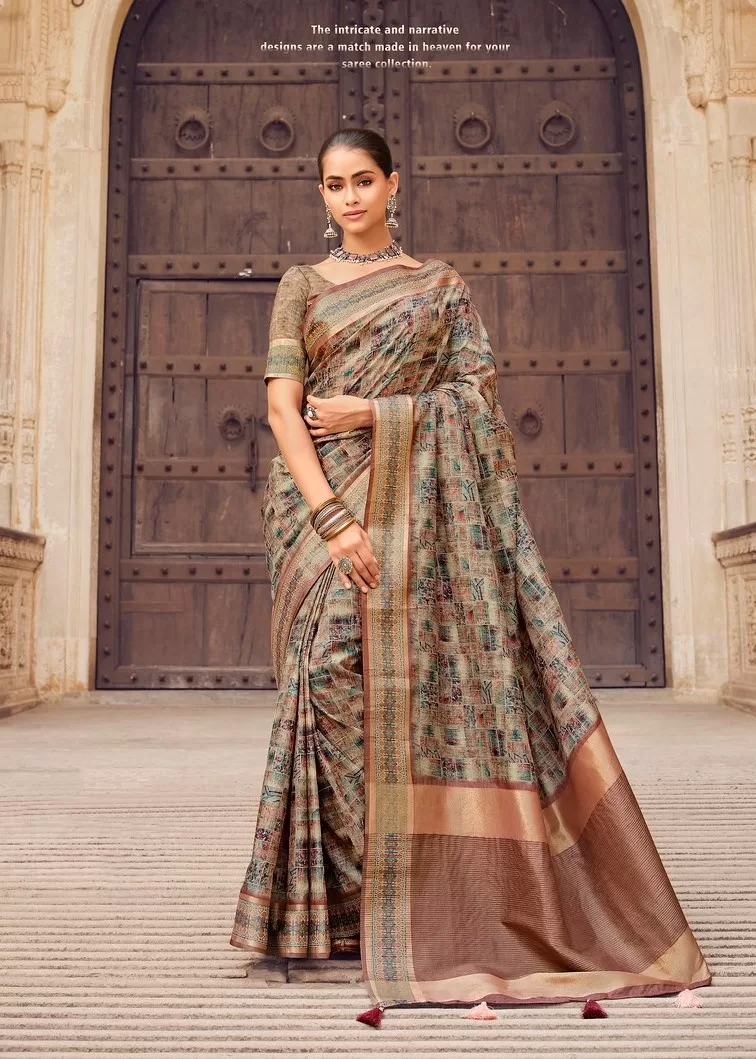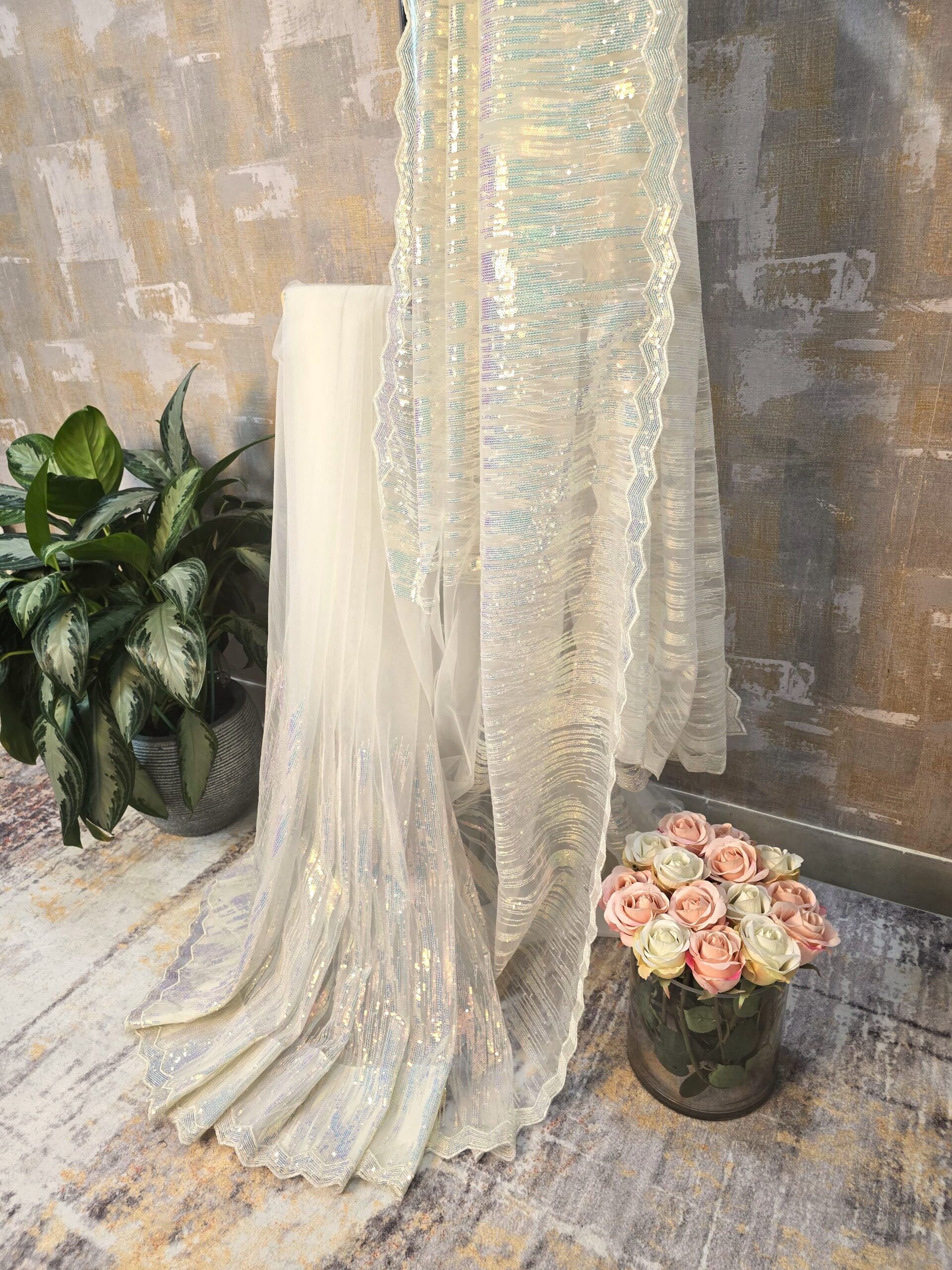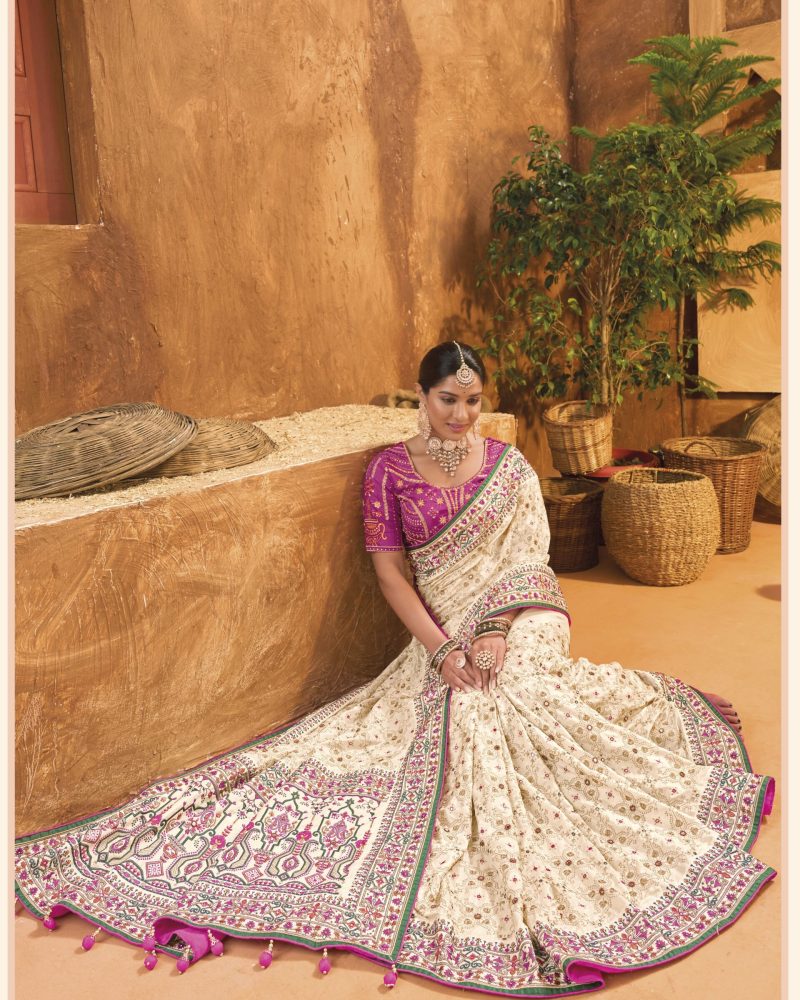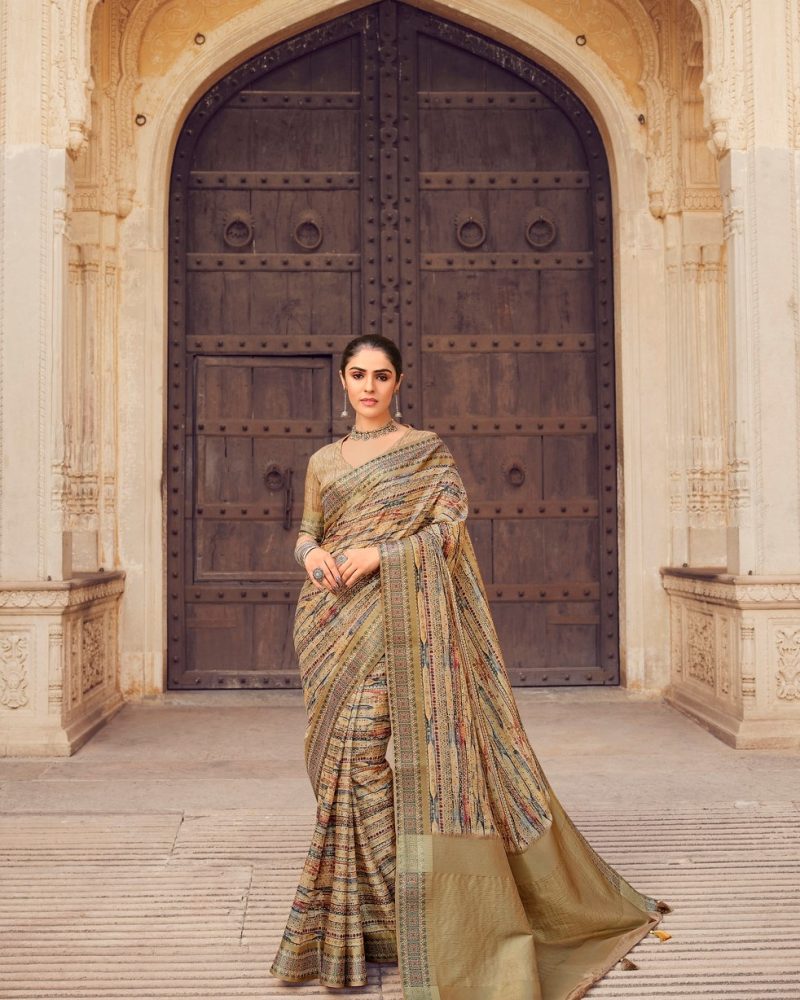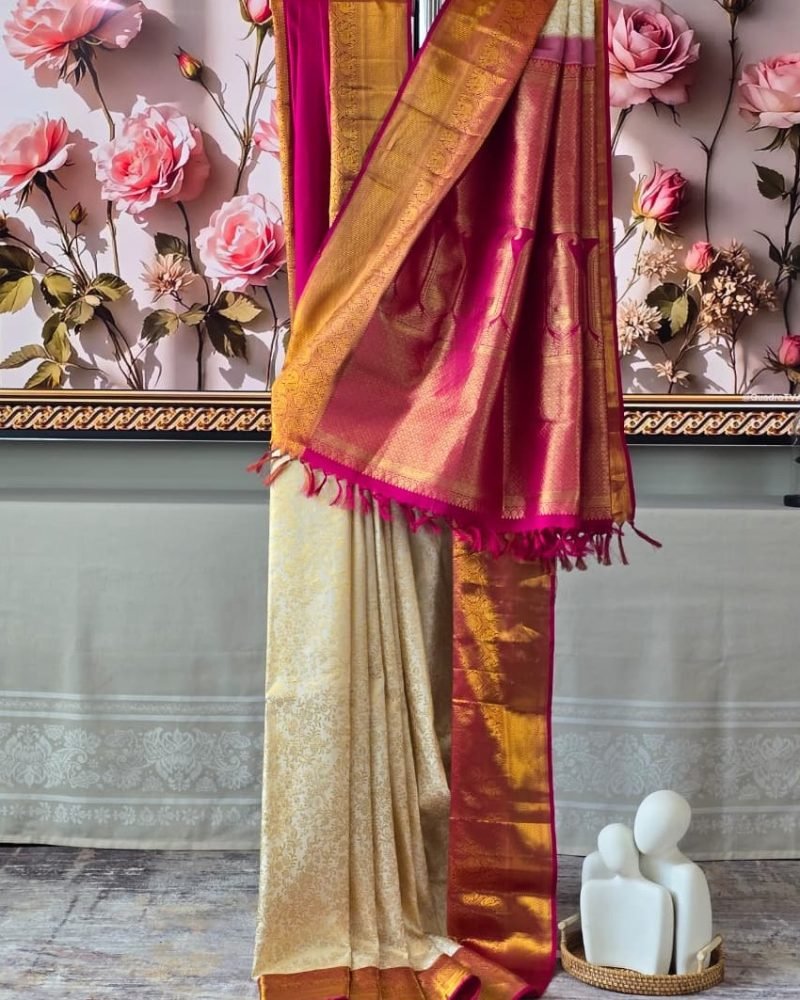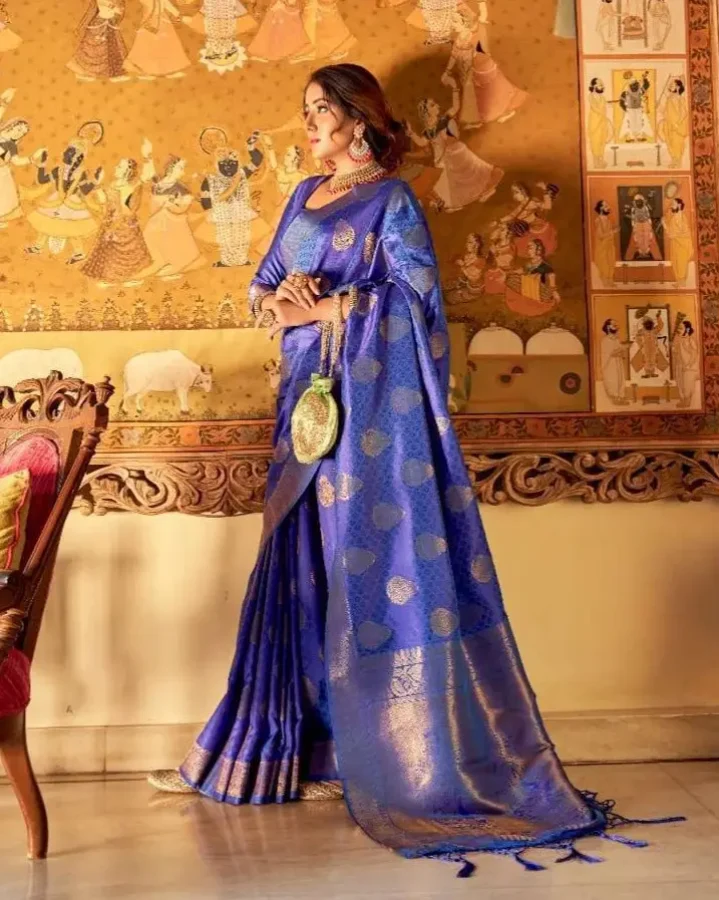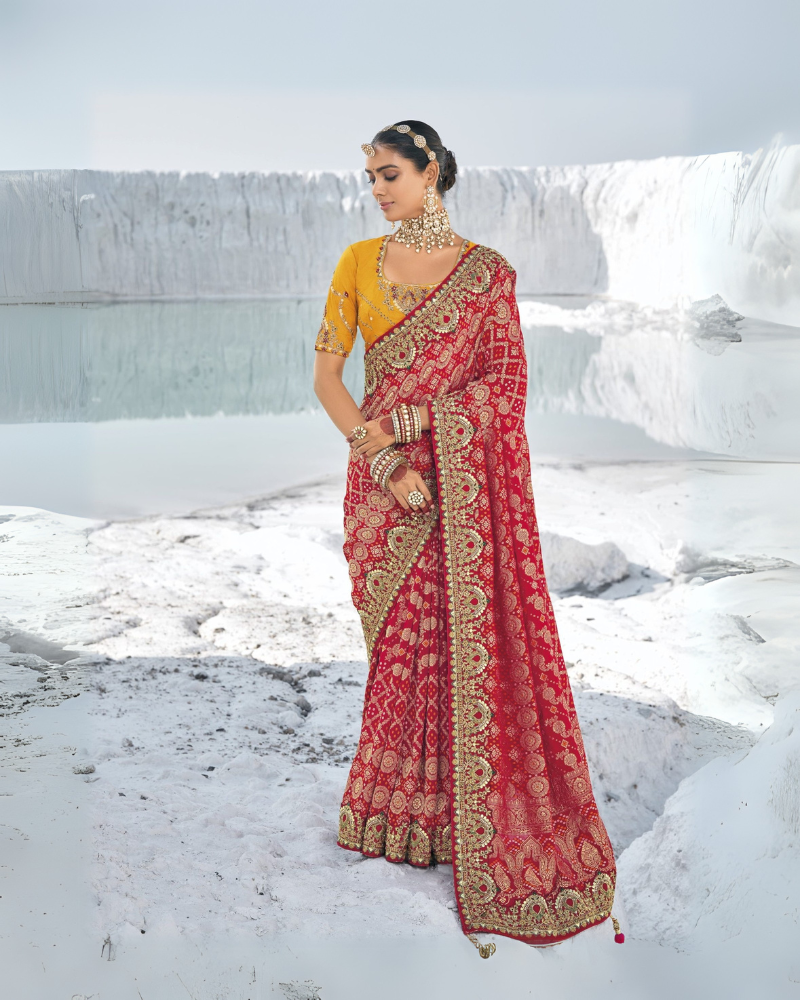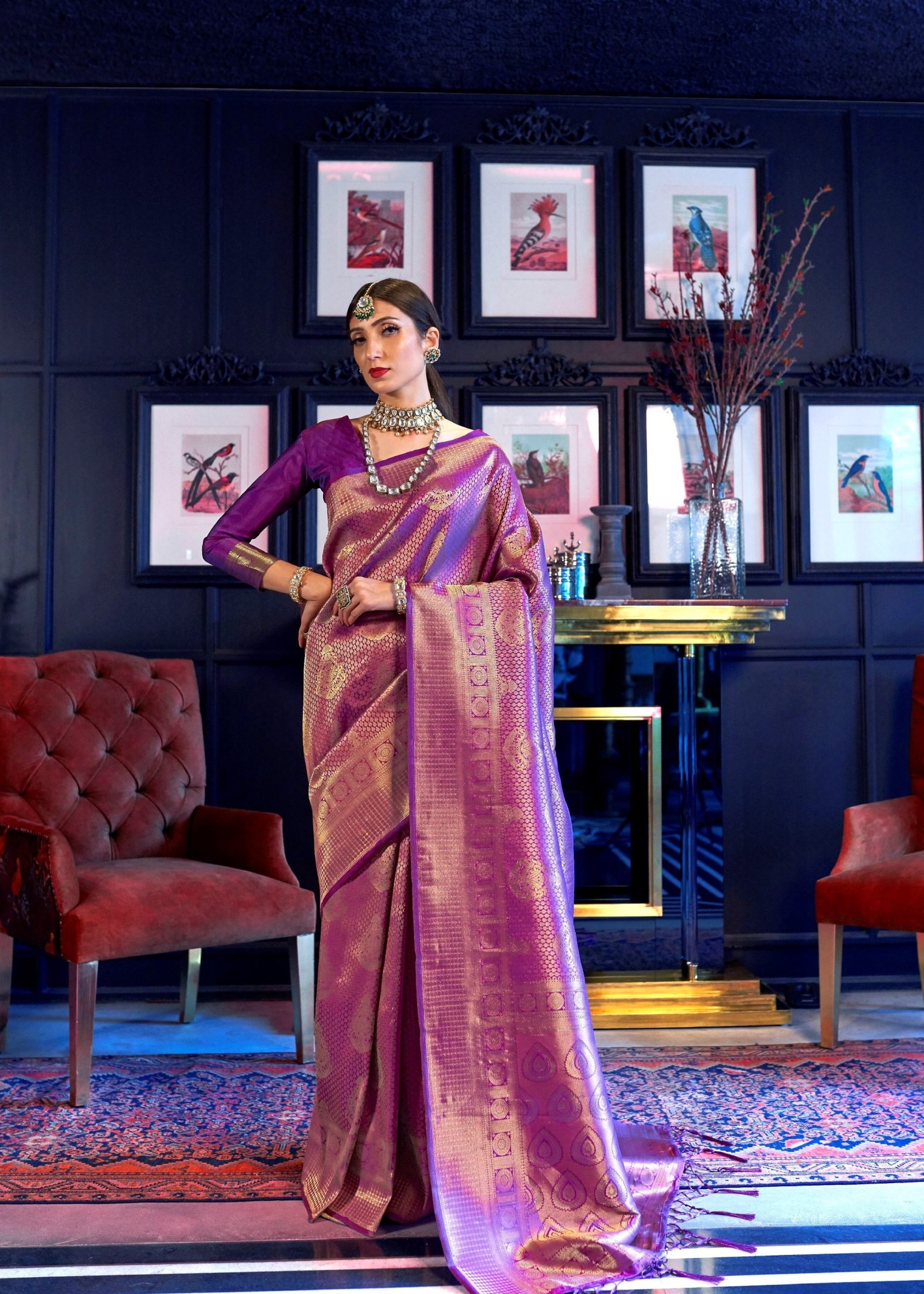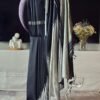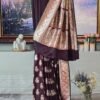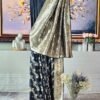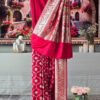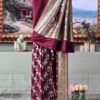The Kanjivaram saree also known as Kanchipuram saree or pattu saree is one of India’s most iconic silk sarees, synonymous with luxury, elegance, and cultural richness. Handwoven in the temple town of Kanchipuram, Tamil Nadu, these sarees are revered for their pure silk fabric, contrasting borders, and rich zari work, making them an essential part of bridal trousseaux and festive wardrobes.
But there’s more to these sarees than just beauty, they are deeply rooted in history, mythology, and skilled craftsmanship.
Origin: From the Temple Town of Kanchipuram
Located about 75 km from Chennai, Kanchipuram is famously known as the “City of a Thousand Temples.” While its spiritual and architectural heritage draws pilgrims from across India, it is equally celebrated as a renowned silk weaving centre.
Despite its modest size, Kanchipuram has put itself on the global textile map, and in 2005, its sarees were granted a Geographical Indication (GI) tag, recognizing their authenticity and cultural importance.
Mythological Legacy: A Divine Lineage of Weavers
According to Hindu mythology, the Kanchipuram weavers are believed to be descendants of Sage Markandeya, a legendary weaver who created garments for the gods. He is said to have woven fabrics from lotus fibre for Lord Shiva himself, embedding the art of weaving with divine purpose.
This mythological connection adds a spiritual dimension to each Kanjivaram saree, making it more than just a piece of clothing, it becomes a sacred symbol of culture and continuity.
Characteristics of a Traditional Kanjivaram Saree
A Kanjivaram saree isn’t just defined by its beauty, it is admired for its fine craftsmanship, durability, symbolic motifs, and regional authenticity. Below are the key elements that define a traditional Kanjivaram saree:
1. Fabric: Pure Mulberry Silk
At the heart of every Kanjivaram saree is pure mulberry silk, known for its:
- High tensile strength, making the saree long-lasting and tear-resistant
- Natural sheen and smooth texture, giving the fabric a regal appearance
- Heaviness, which adds a luxurious drape and structure to the saree
The silk is primarily sourced from the southern states of Tamil Nadu, Karnataka, and Andhra Pradesh, then dyed and woven in Kanchipuram using traditional techniques passed down through generations.
2. Zari: The Golden Touch
One of the standout features of a Kanjivaram saree is the use of zari, metallic threads that embellish the borders, pallus, and sometimes the body.
Traditionally, Kanjivarams were woven with pure silver and gold zari, which gave them unmatched opulence. In modern times, due to changing tastes and price considerations, artisans also use:
- Silver-coated copper zari
- Antique-finish zari
- Coloured zari (such as pink, rose gold, or copper)
These alternatives still deliver a striking aesthetic, while making Kanjivarams more affordable for a wider audience.
3. Colour Palette: Bold Contrasts & Timeless Tones
One of the most visually striking elements of a Kanjivaram saree is its vibrant colour contrast between the body, border, and pallu. This contrast is achieved through a unique weaving method (often the Korvai technique) where different colored threads are interlocked without cutting the yarn.
Traditionally used colours include:
- Bold and auspicious shades like red, green, maroon, mustard, and royal blue
- Gold and off-white for classic bridal and ceremonial looks
However, modern Kanjivarams have expanded to include:
- Soft pastels, ivory-gold combinations, and dual-tone shades
- Unique colour gradients created using double-warp threads
This evolution in colours ensures Kanjivarams appeal to both traditionalists and contemporary wearers.
4. Motifs: Stories Woven in Silk
Kanjivaram motifs are more than just decorative, they are deeply symbolic and often inspired by:
Temple Architecture:
Motifs like gopurams (temple towers), pillars, and mandala patterns reflect the spiritual and architectural heritage of South India.
Fauna & Nature:
Popular elements include:
- Peacocks – symbolizing grace, beauty, and elegance
- Elephants – representing royalty and strength
- Parrots and swans – signifying love, purity, and devotion
- Mango (paisley) – an age-old symbol of abundance and fertility
Mythological Creatures:
Unique to Kanjivaram sarees are figures like:
- Yaali – a mythical lion-elephant hybrid, denoting protection and power
- Pakshi – the twin-headed bird, symbolizing mysticism and spiritual duality
Each motif tells a story rooted in South Indian folklore, spirituality, and natural beauty making every Kanjivaram saree a piece of wearable art.
These timeless characteristics not only contribute to the saree’s visual grandeur but also its cultural significance making the Kanjivaram saree a cherished heirloom across generations.
Signature Weaving Techniques: What Makes Kanjivaram Sarees Unique
One of the key reasons why Kanjivaram sarees stand out in the world of handloom textiles is their exceptional weaving techniques, many of which are unique to the region of Kanchipuram. These methods are not only technically sophisticated but also visually impactful, resulting in sarees that are both luxurious and long-lasting.
Below are two of the most iconic and distinctive weaving styles associated with Kanjivaram sarees:
Korvai Weave – The Art of Contrast
Korvai (meaning “joining” in Tamil) is one of the most defining techniques of traditional Kanjivaram sarees. In this method: The body, border, and pallu of the saree are woven separately, often in contrasting colours. These sections are then manually interlocked at the loom by skilled weavers, creating a seamless join that is strong and durable. The technique results in sharply defined borders with a slight ridge, which is a hallmark of authentic Kanjivarams.
Korvai weaving is labour-intensive, often requiring two or more weavers to work together on a single saree. The precision and expertise involved in this method make Korvai Kanjivarams a premium choice, especially for bridal wear and heirloom collections.
Vairaoosi Kanjivaram – The Sheen of Subtle Luxury
Vairaoosi (sometimes spelled Vaira Oosi) refers to a unique style of Kanjivaram saree that features: Fine metallic zari threads (traditionally silver or gold) woven through the entire body of the saree, not just the border or pallu. This technique creates a delicate, shimmering effect across the saree, giving it a glossy, radiant finish.
The zari is woven in such a way that it mimics the look of threads of light scattered across the silk hence the name “Vaira Oosi”, which literally translates to “diamond needle”.
Vairaoosi sarees are highly sought after for weddings and ceremonial occasions, especially when understated elegance is preferred over bold contrast. The overall aesthetic is subtle yet undeniably regal.
Both the Korvai and Vairaoosi weaving techniques showcase the technical brilliance and artistic innovation of Kanchipuram’s master weavers. These methods are not just about design, they are about preserving a legacy of handloom excellence, which has been honed over centuries.
Whether you’re drawn to the bold contrasts of Korvai or the glimmering elegance of Vairaoosi, each technique offers a distinct identity and timeless appeal to the Kanjivaram saree.
Cultural Significance: More Than Just a Saree
A Kanjivaram saree is not merely a garment, it is a living expression of heritage, identity, and emotion. Woven with deep-rooted tradition, it holds immense cultural value in South Indian society, and increasingly, across all of India.
A Symbol of Auspiciousness in South Indian Weddings
In Tamil Nadu, Andhra Pradesh, Karnataka, and Kerala, a wedding is considered incomplete without the bride draped in a Kanjivaram saree often in hues of red, gold, or maroon. These sarees are believed to:
- Bring blessings of prosperity, fertility, and marital bliss
- Act as a visual representation of traditional values and purity
- Serve as a marker of a family’s heritage, status, and pride
The rich silk and gleaming zari signify the divine and the sacred, making Kanjivarams not just preferred, but essential, for ceremonial occasions like weddings, temple festivals, and family rituals.
Heirlooms Passed Across Generations
More than fashion, a Kanjivaram saree is a family legacy. It is often: Handpicked by mothers or grandmothers for a daughter’s wedding, Worn during a woman’s milestones from engagement to baby showers, Passed down as a treasured heirloom with emotional and spiritual significance
Owning a Kanjivaram saree is like owning a piece of one’s ancestry woven with memories, blessings, and love.
Loved Across India: Beyond Regional Borders
Though deeply rooted in South Indian culture, the timeless elegance and craftsmanship of Kanjivaram sarees have made them popular across India and among the Indian diaspora worldwide.
Today, women from all walks of life irrespective of region, religion, or age proudly wear Kanjivarams during:
- Weddings and religious ceremonies
- Festivals like Diwali, Durga Puja, and Pongal
- Cultural events, award functions, and even modern office parties (in softer silk versions)
This widespread appeal has helped Kanjivaram sarees transcend boundaries, making them a national symbol of grace and tradition.
Modern Adaptations: Bridging Tradition & Trend
While the Kanjivaram saree is steeped in centuries-old tradition, it continues to evolve gracefully with changing times. Today’s designers and weavers are reimagining the classic Kanjivaram, blending traditional techniques with contemporary aesthetics to appeal to a wider and younger audience.
These innovations have ensured that Kanjivaram sarees remain fashion-forward without losing their soul.
1. Fusion Designs: Where North Meets South
One of the most exciting developments in recent years is the integration of motifs and patterns from other weaving traditions, especially from northern India.
- Banarasi jaal work, known for its intricate floral vines and brocade-like texture, is being blended with Kanjivaram’s bold silk base.
- Delicate floral motifs, previously uncommon in traditional Kanjivarams, are now being incorporated for a softer, more romantic appeal.
- This North-South textile fusion caters to modern brides and festive wearers looking for something timeless yet different.
Result: A fresh, cross-cultural look that retains authenticity while offering design novelty.
2. Contemporary Colours: Beyond the Bold and Bright
Traditionally, Kanjivaram sarees featured rich jewel tones like red, green, gold, and royal blue colours associated with prosperity and auspiciousness. However, modern preferences have expanded the colour palette significantly:
- Pastel shades like powder blue, blush pink, and mint green now offer a softer, understated elegance.
- Dual-tone (shot colour) silks, created by weaving two different coloured threads, produce iridescent hues that shift with light.
- Neutral tones like ivory, beige, and grey are also gaining popularity for daytime events and minimalist weddings.
Result: Greater versatility, allowing Kanjivarams to be worn for both grand events and intimate gatherings.
3. Experimental Zari: Beyond Gold and Silver
While traditional Kanjivaram sarees use pure gold or silver zari, modern versions are exploring innovative metallic finishes that cater to evolving style sensibilities:
- Pink and rose gold zari adds a fresh and feminine touch
- Copper zari lends an antique, earthy charm
- Matte or oxidized finishes provide a more subtle and contemporary feel
These adaptations make the saree feel less opulent yet still luxurious, perfect for younger women who prefer refined glamour over overt shine.
Result: Kanjivarams that feel luxurious without being overwhelming.
These modern adaptations make Kanjivaram sarees more inclusive and versatile, enabling:
- Young brides to find designs that reflect their personal style
- Professionals to wear lighter, sleeker versions for office or events
- Fashion enthusiasts to blend tradition with trend effortlessly
By staying relevant while honouring its origins, the Kanjivaram saree continues to inspire admiration across ages, geographies, and generations.
The Challenge of Power Looms: A Double-Edged Sword
In recent years, power loom versions of Kanjivaram-inspired sarees have flooded the market. These are more affordable and accessible, but they lack the authenticity and craftsmanship of handwoven sarees. While they help expand reach, they’ve caused economic pressure on traditional weavers. However, many buyers continue to seek authentic handloom Kanjivarams for their durability, richness, and heritage value.
Tip for Shoppers: Always look for the Silk Mark or GI tag label to ensure you’re buying an original handwoven Kanjivaram saree.
Where to Buy Kanjivaram Sarees Online?
At Sarees By Muhurat, we bring you authentic handwoven Kanjivaram sarees directly from traditional weaving families in Tamil Nadu. From classic bridal pieces to modern soft silk Kanjivarams, our curated collection is designed to suit every occasion and every generation.
